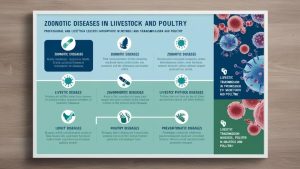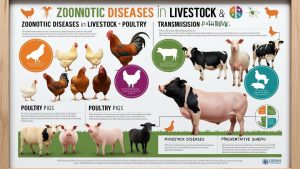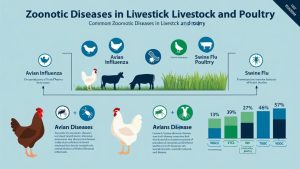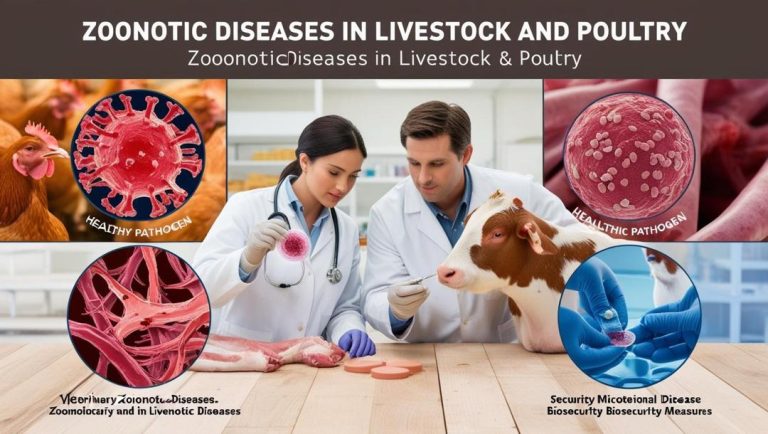Zoonotic diseases, also known as zoonoses, are infections that can be transmitted between animals and humans. These diseases pose significant risks to public health, food security, and economic stability, particularly in regions where livestock and poultry farming are integral to livelihoods. Understanding zoonotic diseases in livestock and poultry is crucial for preventing outbreaks, ensuring safe animal production, and protecting human health.
This article provides an in-depth exploration of zoonotic diseases in livestock and poultry, including their causes, transmission, symptoms, prevention, and control strategies.
Click HERE to join our WhatsApp group
Understanding Zoonotic Diseases
Zoonotic diseases can be caused by a variety of pathogens, including:
Bacteria: Salmonella, Brucella, Campylobacter
Viruses: Avian Influenza, Rabies, Nipah virus
Parasites: Toxoplasma, Cryptosporidium, Echinococcus
Fungi: Ringworm, Histoplasmosis
The transmission of zoonotic diseases can occur through direct contact with infected animals, consumption of contaminated food or water, insect vectors, and exposure to contaminated environments.
Common Zoonotic Diseases in Livestock

a) Brucellosis
Cause: Brucella bacteria
Transmission: Direct contact with infected animals, consumption of unpasteurized dairy products
Symptoms in Animals: Reproductive failure, abortions, weak offspring
Symptoms in Humans: Fever, joint pain, fatigue, muscle aches
Prevention: Vaccination, pasteurization of milk, proper hygiene practices
b) Anthrax
Cause: Bacillus anthracis bacteria
Transmission: Inhalation, ingestion, or direct contact with spores in contaminated soil, feed, or carcasses
Symptoms in Animals: Sudden death, fever, bloody discharge
Symptoms in Humans: Skin lesions, respiratory distress, septicemia
Prevention: Proper carcass disposal, vaccination, protective equipment for handling animals
READ ALSO: Nutritional Requirements for Quails
c) Tuberculosis (TB)
Cause: Mycobacterium bovis
Transmission: Inhalation of aerosols, consumption of raw milk from infected cattle
Symptoms in Animals: Respiratory distress, weight loss, chronic cough
Symptoms in Humans: Persistent cough, weight loss, fever, fatigue
Prevention: Regular testing and culling of infected animals, pasteurization of milk
d) Leptospirosis
Cause: Leptospira bacteria
Transmission: Contact with urine from infected animals, contaminated water or soil
Symptoms in Animals: Jaundice, kidney failure, reproductive issues
Symptoms in Humans: Fever, muscle pain, kidney or liver damage
Prevention: Vaccination, proper sanitation, rodent control
e) Q Fever
Cause: Coxiella burnetii bacteria
Transmission: Airborne particles from infected animals, contact with contaminated birth fluids
Symptoms in Animals: Usually asymptomatic, occasional abortions
Symptoms in Humans: Flu-like symptoms, pneumonia, chronic fatigue
Prevention: Proper handling of animal products, disinfection of contaminated areas
Common Zoonotic Diseases in Poultry

a) Avian Influenza (Bird Flu)
Cause: Influenza A virus (H5N1, H7N9 strains)
Transmission: Direct contact with infected birds, contaminated surfaces
Symptoms in Birds: Respiratory distress, decreased egg production, high mortality
Symptoms in Humans: Fever, cough, pneumonia, severe respiratory illness
Prevention: Biosecurity measures, avoiding contact with wild birds, vaccination
READ ALSO: Free-Range vs. Cage System in Poultry Farming
b) Salmonellosis
Cause: Salmonella bacteria
Transmission: Contaminated poultry products (eggs, meat), direct contact with infected birds
Symptoms in Birds: Often asymptomatic, but can cause diarrhea and lethargy
Symptoms in Humans: Gastrointestinal issues (diarrhea, vomiting, fever)
Prevention: Proper cooking of poultry products, hygiene in food handling
c) Campylobacteriosis
Cause: Campylobacter bacteria
Transmission: Contaminated poultry meat, unclean water
Symptoms in Birds: Generally asymptomatic
Symptoms in Humans: Severe diarrhea, fever, abdominal pain
Prevention: Cooking meat thoroughly, hygiene practices, clean water sources
d) Newcastle Disease
Cause: Newcastle Disease Virus (NDV)
Transmission: Aerosols, contaminated feed, direct contact with infected birds
Symptoms in Birds: Respiratory distress, nervous system disorders, high mortality
Symptoms in Humans: Mild flu-like symptoms, conjunctivitis
Prevention: Vaccination, quarantine of infected flocks, disinfection
e) Psittacosis (Parrot Fever)
Cause: Chlamydia psittaci bacteria
Transmission: Inhalation of dried feces or secretions from infected birds
Symptoms in Birds: Respiratory distress, lethargy
Symptoms in Humans: Fever, headache, pneumonia-like symptoms
Prevention: Proper bird handling, disinfection, avoiding close contact with infected birds
READ ALSO: Role of Probiotics and Prebiotics in Animal Health
Prevention and Control Strategies for Zoonotic Diseases

a) Biosecurity Measures
Implement strict farm hygiene practices.
Restrict access to poultry and livestock facilities.
Disinfect equipment and facilities regularly.
b) Vaccination Programs
Vaccinate animals against common zoonotic diseases.
Maintain up-to-date vaccination records.
c) Proper Animal Husbandry
Provide clean and adequate housing.
Ensure proper nutrition to boost immunity.
Control rodent and insect populations to prevent disease spread.
d) Safe Food Handling and Processing
Cook meat, eggs, and dairy products thoroughly.
Pasteurize milk to eliminate bacterial contamination.
Maintain cold storage for raw animal products.
e) Public Health Education
Train farmers, butchers, and consumers on zoonotic disease risks.
Promote awareness of proper animal handling and hygiene.
Encourage medical consultation for symptoms related to zoonotic infections.
f) Surveillance and Early Detection
Conduct regular screening of livestock and poultry for zoonotic pathogens.
Report disease outbreaks to relevant authorities.
Implement quarantine measures for affected animals.
Conclusion
Zoonotic diseases in livestock and poultry pose significant risks to animal and human health. Effective prevention and control measures, such as biosecurity, vaccination, safe food handling, and public awareness, are essential for mitigating these risks. Farmers, veterinarians, public health officials, and consumers all play a role in preventing the spread of zoonotic diseases. By adopting best practices and staying informed, we can ensure safer livestock and poultry farming while protecting human health.
READ ALSO: Feed Processing and Preservation Techniques
Feed processing and preservation are essential for maintaining nutritional quality, preventing spoilage, and enhancing digestibility in livestock and poultry diets. Proper processing ensures efficient feed utilization, reduces wastage, and improves animal performance…
READ ALSO: Fermented Feeds and Their Benefits in Animal Nutrition
Fermented feeds have gained popularity in animal nutrition due to their ability to improve digestibility, enhance gut health, and boost overall animal performance. Fermentation is a natural process that involves the action of beneficial microorganisms, such as bacteria and yeasts, on feed ingredients. This process enhances nutrient availability, preserves feed quality, and introduces beneficial probiotics that support animal health…
Click HERE to join our WhatsApp group

